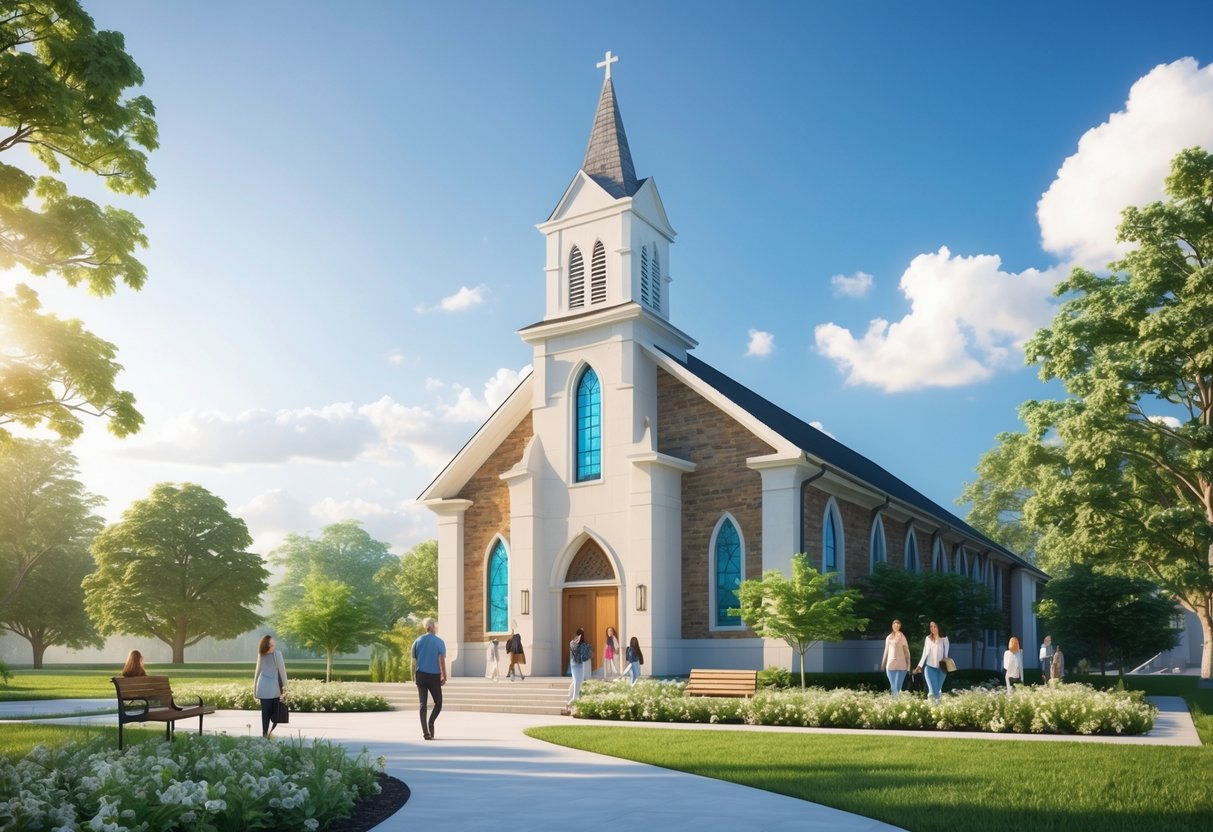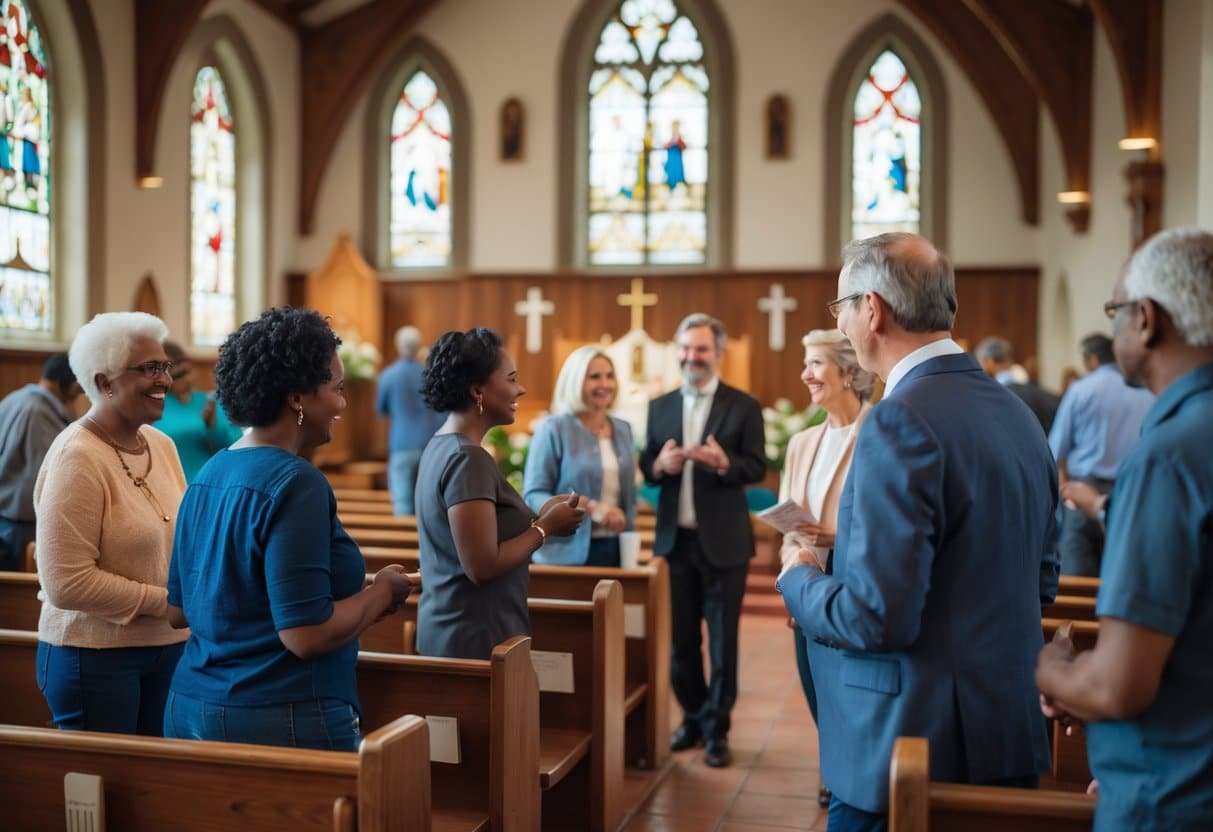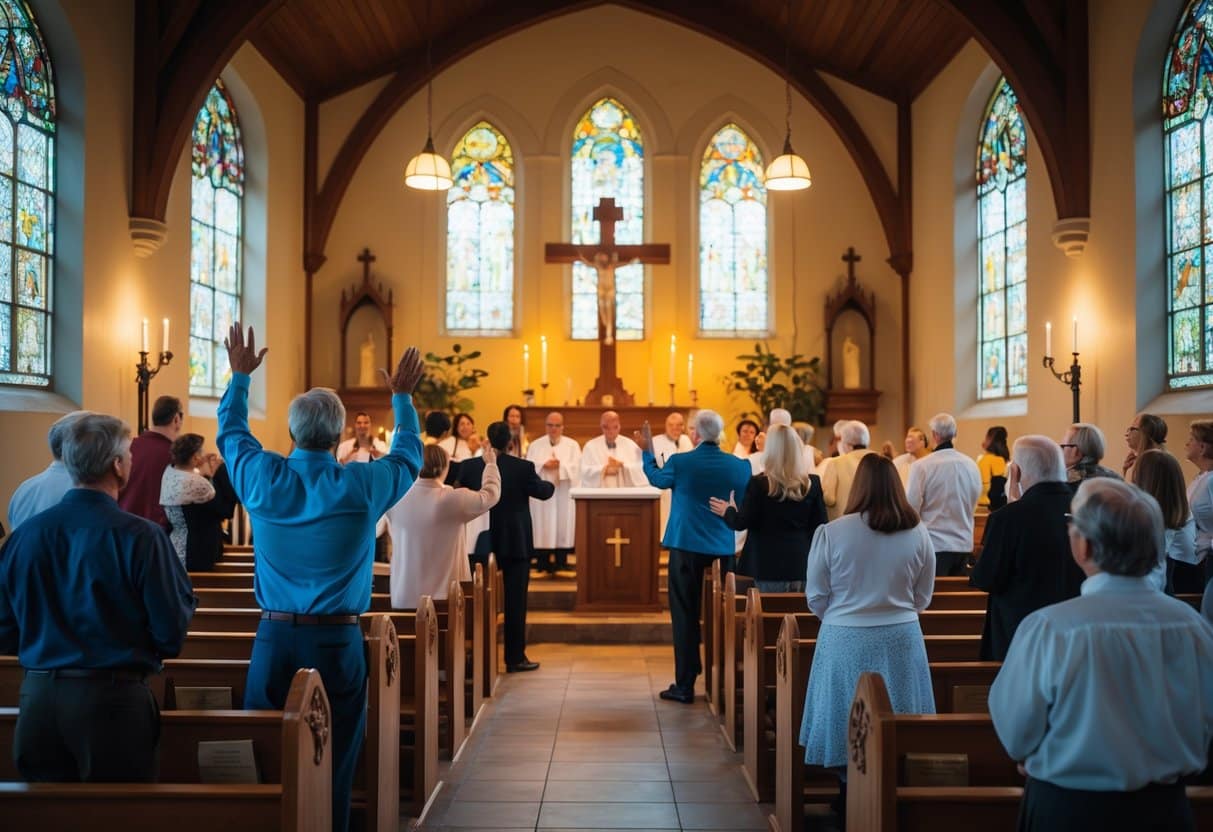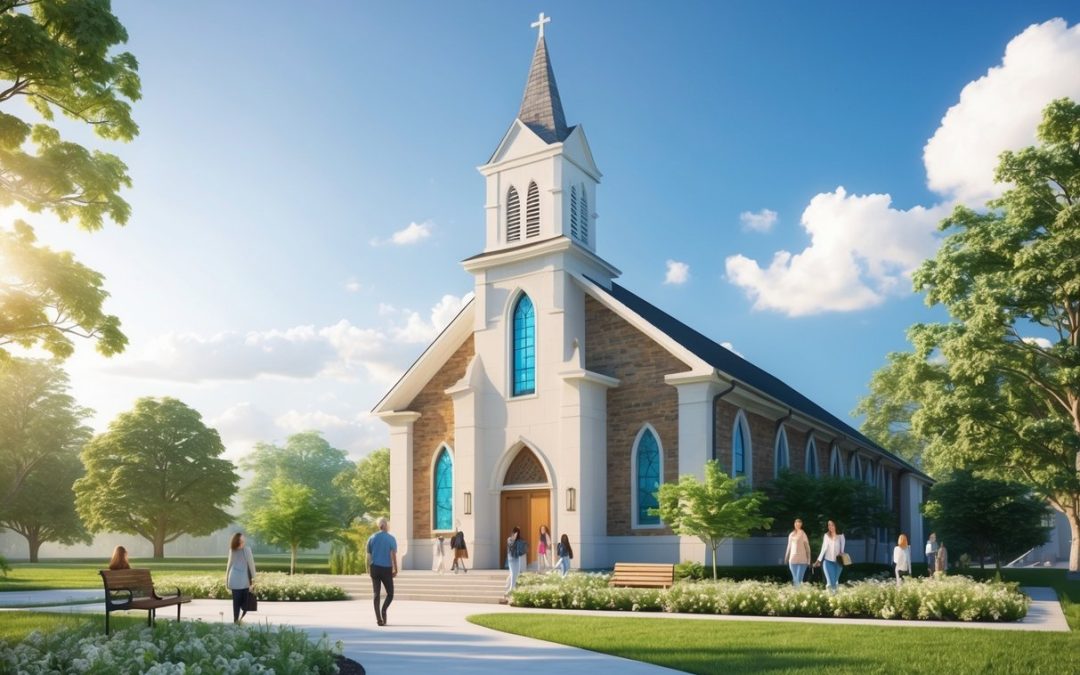Traditional churches offer unique advantages that have drawn people to worship for centuries. These churches focus on time-tested practices, formal worship services, and deep community connections that many believers find meaningful.

Traditional churches provide spiritual stability through established liturgies, strong community bonds, and preservation of Christian heritage that has guided believers for generations. Many people discover that traditional worship contains rich theological content that speaks directly to core Christian beliefs. The formal structure and familiar rituals create a sense of reverence that helps worshippers connect with God.
Traditional churches function today with renewed purpose while maintaining their historical roots. They offer dependable financial stability, experienced leadership, and multi-generational wisdom that newer church models often lack. These benefits make traditional churches appealing to people seeking depth and continuity in their faith journey.
Key Takeaways
- Traditional churches provide spiritual stability through established worship practices and time-tested Christian traditions
- These churches create strong community connections that bring together multiple generations of believers
- Traditional worship services offer theological depth and formal structure that help people connect meaningfully with their faith
Understanding Traditional Church Benefits

Traditional churches offer unique advantages through their established practices and deep historical roots. These faith communities provide stability, time-tested worship methods, and strong financial foundations that benefit members in many ways.
Defining a Traditional Church
A traditional church encompasses Christian denominations that follow long-standing practices and beliefs passed down through generations. These churches prioritize preserving historical practices and doctrines.
Key characteristics include:
- Formal worship services with structured liturgy
- Emphasis on denominational traditions like Lutheran or Methodist practices
- Buildings, budgets, staff, and Sunday services as core elements
- Adherence to established faith traditions spanning centuries
Traditional churches focus on maintaining the customs and beliefs their denominations have practiced for many years. They value consistency in how they conduct services and teach Christian doctrine.
The structure helps members know what to expect each week. This predictability creates comfort for people who appreciate routine in their spiritual lives.
Core Values and Practices
Traditional churches center their activities around the preservation of Christian tradition and formal worship experiences. They emphasize the importance of liturgy and ceremonial elements during services.
Financial stability stands out as a major strength. Church members maintain dependable finances because people who have given over time want their investments protected. These churches save money carefully and work hard to preserve it.
Family-focused ministry plays a central role. Traditional churches help families grow in faith together by making children feel welcome and ensuring teens feel heard.
Community traditions include social gatherings and shared meals. The best cooks and cooking await members at traditional church events.
These churches invest in young people with vision for both present and future growth. They maintain strong educational programs and youth ministries.
Comparison to Other Church Models
Traditional churches differ significantly from contemporary and house church models in structure and approach. While contemporary churches focus on modern music and casual atmospheres, traditional churches maintain formal worship styles.
Versus Contemporary Churches:
- Traditional churches use hymns and organ music
- Services follow set liturgical patterns
- Dress codes tend to be more formal
- Architecture often features classic church designs
Versus House Churches:
House churches offer intimate gatherings with personalized worship experiences in homes. Traditional churches provide larger community settings with established programs and facilities.
Traditional churches typically have more resources for programming due to their size and financial stability. They can support multiple ministries, paid staff, and building maintenance.
The formal structure appeals to people who prefer organized worship and clear leadership roles. Members benefit from the stability and predictability these churches provide through their established systems.
Spiritual Growth Through Traditional Worship

Traditional worship creates a foundation for deep spiritual growth through structured engagement with God’s word, intentional formation practices, and disciplined faith routines. These elements work together to nurture believers’ relationship with God and strengthen their spiritual maturity.
Engagement With Scripture
Traditional worship places scripture at the center of every service. Churches follow lectionaries that ensure congregants hear from different parts of the Bible throughout the year.
This systematic approach exposes believers to the full range of biblical teachings. They encounter challenging passages they might skip in personal study. The regular rhythm helps people absorb God’s word more deeply.
Scripture reading typically includes:
- Old Testament lessons
- Psalm responses
- New Testament epistles
- Gospel readings
Pastors in traditional settings often preach verse-by-verse through books of the Bible. This method ensures thorough coverage of scripture rather than topical preaching alone.
The responsive readings and recited creeds reinforce biblical truths. When congregants speak these words together, they memorize key scriptures and doctrines. This repetition builds spiritual knowledge over time.
Traditional worship continues to offer theological depth that helps believers grow in their understanding of God’s character and promises.
Encouraging Spiritual Formation
Traditional worship services include specific elements designed to shape believers’ hearts and minds. The liturgical structure guides people through confession, forgiveness, thanksgiving, and commitment.
Confession prayers help believers recognize their need for God’s grace. This weekly practice develops humility and honesty before God. People learn to examine their hearts regularly.
The communion service provides a powerful moment for spiritual reflection. Believers remember Christ’s sacrifice and recommit to following him. This sacrament strengthens their connection to God and other believers.
Key formation elements include:
- Silent prayer times
- Corporate confession
- Assurance of forgiveness
- Communion preparation
Hymns in traditional worship often contain rich theology. The lyrics teach believers about God’s attributes and works. Singing these truths together builds faith and creates shared spiritual experiences.
Worship inspires believers to engage in acts of service, which deepens their spiritual understanding and commitment to God’s kingdom work.
Routine and Discipline in Faith
Traditional worship follows predictable patterns that build spiritual discipline in believers’ lives. The consistent weekly gathering creates accountability and momentum for spiritual growth.
The liturgical calendar guides believers through different seasons of faith. Advent prepares hearts for Christmas. Lent encourages reflection before Easter. These cycles provide structure for spiritual development throughout the year.
Regular attendance at traditional services develops the habit of prioritizing God in weekly schedules. This discipline often extends to personal prayer and Bible study times.
Weekly worship routine typically includes:
- Preparation before service
- Active participation during worship
- Reflection after the service
- Application throughout the week
The rhythmic pattern of traditional worship nurtures spiritual growth through regular prayer, scripture reading, and reflection that becomes part of believers’ spiritual DNA.
The predictable format allows people to focus on God rather than wondering what comes next. This familiarity creates space for deeper spirituality and connection with the divine during worship.
The Role of Traditional Worship Services
Traditional worship services create structure and meaning through time-tested practices that connect believers across generations. These services use liturgical elements, classic hymns, and formal order to provide a sacred space for spiritual growth.
Importance of Liturgical Practices
Liturgical practices form the backbone of traditional worship services. These structured elements include responsive readings, prayers, and ceremonial actions that follow patterns used for centuries.
The liturgy helps worshippers participate in something bigger than themselves. When congregations recite creeds or prayers together, they connect with millions of believers throughout history who spoke the same words.
Traditional churches prioritize the preservation of historical practices that create continuity between past and present. This approach gives church members a sense of belonging to an ancient faith community.
Liturgical seasons like Advent and Lent provide rhythm to church life. These cycles help believers focus on different aspects of their faith throughout the year. The predictable structure allows people to prepare their hearts and minds for worship.
Many find comfort in knowing what to expect during services. The familiar order reduces anxiety and lets worshippers focus on their spiritual connection rather than wondering what comes next.
Significance of Traditional Hymns
Traditional hymns carry deep theological meaning in their lyrics and melodies. These songs teach important truths about God while creating emotional connections to faith.
Traditional worship with its hymns continues to inspire believers across generations. The rich poetry in hymns often contains more complex theological concepts than contemporary songs.
Many hymns tell complete stories of faith. Songs like “Amazing Grace” or “How Great Thou Art” walk singers through spiritual journeys from doubt to trust.
The melodies themselves become part of people’s spiritual memories. Elderly church members often remember hymn tunes even when other memories fade. These songs provide comfort during difficult times.
Traditional hymns also create unity across different churches. A Methodist and a Presbyterian can attend each other’s services and sing familiar songs together. This shared musical heritage strengthens the broader Christian community.
Sense of Reverence and Order
Traditional worship creates an atmosphere of respect and awe that helps people encounter God. The formal structure and careful planning show that worship deserves special attention and preparation.
Good worship services help people detach from the present world to connect with the divine. The reverent tone sets traditional worship apart from everyday activities.
Specific elements build this sacred atmosphere. Quiet moments for reflection, formal prayers, and respectful behavior all contribute to a sense of God’s presence.
The predictable order allows deeper spiritual focus. When people know the service flow, they can concentrate on prayer and meditation instead of following along with new formats.
Traditional worship often includes moments of silence that contemporary services might fill with activity. These quiet spaces give the Holy Spirit room to work in people’s hearts.
The careful pace prevents worship from feeling rushed or casual. Each element receives proper attention, showing that meeting with God deserves time and thoughtfulness.
Community and Intergenerational Connection
Traditional churches create spaces where people of all ages come together to worship, learn, and grow. These communities help different generations form meaningful bonds while building a sense of belonging for everyone.
Building Lasting Relationships
Traditional churches naturally bring people together through weekly services, Bible studies, and shared activities. Members see the same faces week after week, which helps friendships grow over time.
These regular meetings create trust between church members. People share their struggles and celebrate good news together. Strong friendships often develop when members pray for each other during hard times.
Church activities like potluck dinners and volunteer projects give people chances to connect outside of Sunday worship. Intergenerational faith experiences uniquely nurture spiritual growth in both adults and children.
Many traditional churches also have small groups that meet in homes. These smaller gatherings help shy members feel more comfortable opening up to others.
Promoting Unity and Inclusion
Traditional church services welcome people from different backgrounds, ages, and life stages. Everyone sits together in the same sanctuary and participates in the same worship experience.
This shared worship creates a sense of unity that is hard to find in other places. Rich and poor, young and old, all sing the same songs and hear the same message.
Churches often have special roles for different age groups. Older members might serve as mentors while younger people help with music or technology. This gives everyone a chance to contribute their skills.
Building intergenerational faith connections helps pass down traditions and teachings while creating understanding between generations.
Bridging Generations
Traditional churches help different age groups learn from each other in ways that don’t happen naturally in daily life. Grandparents without grandchildren nearby can connect with young families.
Older members share wisdom from their life experiences while younger people bring fresh energy and new ideas. This exchange benefits everyone in the church community.
Many churches have intergenerational ministry programs that pair teens with senior members for special projects. These partnerships help break down age barriers.
Sunday school classes and youth programs often invite older members to share stories about their faith journey. These conversations help younger people see how faith grows over a lifetime.
Traditional churches also celebrate milestones together. The whole congregation witnesses baptisms, confirmations, and weddings, creating shared memories across generations.
Preserving Christian Tradition and Heritage
Churches maintain their spiritual foundation by connecting believers to centuries of faith practices. Traditional worship forms serve as custodians of cultural heritage while keeping congregations rooted in their historical identity.
Continuity With Christian History
Churches create strong bonds between past and present through established practices. Church traditions provide a sense of identity, history, and guidance that connects modern believers to their spiritual ancestors.
Traditional elements like liturgy, hymns, and rituals help congregations experience worship the same way Christians have for generations. These practices create a shared experience across time periods.
Historical worship elements include:
- Ancient prayers and creeds
- Traditional hymns and music
- Seasonal celebrations like Easter and Christmas
- Communion and baptism ceremonies
Many churches preserve original language prayers or maintain architectural features that reflect their heritage. These connections help believers understand their place in the larger Christian story.
The continuity also provides stability during times of change. When society shifts rapidly, traditional practices offer a steady foundation that has weathered many storms throughout history.
Passing Down Faith Practices
Churches actively teach younger generations about established customs and beliefs. Christian traditions endure through intentional teaching, storytelling, and active participation.
Sunday schools often focus on explaining the meaning behind traditional practices. Children learn why certain rituals matter and how they connect to Bible teachings.
Methods for passing down traditions:
- Family worship practices – Parents model traditional prayers and Bible reading
- Mentorship programs – Older members guide younger believers
- Special ceremonies – Confirmation classes teach church history
- Holiday celebrations – Seasonal events reinforce traditional meanings
Many congregations pair older members with younger families to share knowledge about church customs. These relationships help preserve not just the practices but also the stories behind them.
Churches also use modern tools like videos and interactive lessons to make traditional concepts more accessible to younger audiences while maintaining their original meaning.
Educational Benefits and Bible Study
Traditional churches provide organized ways to learn about faith through classes and group studies. These programs help people understand scripture better and grow in their knowledge.
Structured Learning Environments
Churches offer organized classes that teach the Bible in clear, step-by-step ways. Sunday school programs provide age-appropriate lessons for children, teens, and adults. These classes follow planned curricula that cover different books of the Bible over time.
Many churches also host Bible colleges or seminary programs. These faith-based education programs give students a deeper understanding of scripture and theology.
Key features of church education include:
- Weekly classes with trained teachers
- Study materials and workbooks
- Discussion time for questions
- Homework assignments for deeper learning
Adult education programs help members learn about church history, theology, and biblical interpretation. These classes meet regularly and follow structured lesson plans.
Guided Bible Study Groups
Small group Bible studies give members personal attention and focused learning. These groups typically have 8-15 people who meet weekly in homes or church rooms.
A trained leader guides each session using study guides or specific Bible passages. Bible study provides opportunities to understand scripture more deeply and apply it to daily life.
Benefits of guided study groups:
- Personal discussion of faith questions
- Accountability for regular study
- Diverse perspectives on scripture
- Prayer support from group members
Regular Bible study offers spiritual growth and helps people understand their faith better. Group members can ask questions and share insights in a safe environment.
Leaders often use study books that explain difficult passages and provide historical context. This helps group members understand what they read.
Accessibility and Global Appeal
Traditional churches create welcoming spaces that serve people from all backgrounds and abilities. These sacred spaces offer both physical features and spiritual practices that make worship accessible to diverse communities worldwide.
Physical and Spiritual Accessibility
Traditional church buildings often include features that naturally support accessibility needs. Wide center aisles allow easy movement for wheelchairs and mobility aids. Many older churches have ramps or level entrances that accommodate different physical abilities.
The familiar structure of traditional worship helps people with various disabilities participate more easily. People with disabilities recommend consistent routines and clear expectations during services. Traditional liturgy provides exactly this through predictable prayers and responses.
Printed bulletins and hymnals give visual references for those who need them. Large-print versions of traditional texts are widely available. Many traditional churches also offer hearing assistance devices for members with hearing impairments.
The slow, measured pace of traditional services allows more time for processing. This benefits people with intellectual disabilities or those who need extra time to follow along. Creating accessible worship environments helps everyone participate fully in church activities.
Universal Aspects of Traditional Church
Traditional church practices transcend cultural and language barriers. Basic elements like prayer, music, and communion appear in churches worldwide. These shared traditions create immediate familiarity for travelers and newcomers.
The structure of traditional worship follows similar patterns across denominations. Opening prayers, scripture readings, and closing blessings provide consistent touchpoints. People can participate meaningfully even when visiting unfamiliar congregations.
Traditional hymns often use simple melodies that are easy to learn and remember. Many classic hymns have been translated into multiple languages while keeping the same tunes. This allows diverse congregations to worship together using familiar music.
Church architecture itself communicates spirituality without words. Stained glass windows, altar spaces, and sanctuary layouts create sacred atmospheres that speak to people regardless of their background. Traditional worship elements remain accessible because they rely on universal human experiences of reverence and community.
The formal language of traditional liturgy, while sometimes seen as outdated, actually provides stability across cultures and generations.

